Let’s face it: no matter how reasonable your prices or great your products are, some customers will want to return them. That’s why you need to have a return policy. It sets expectations for your customers and outlines what they can expect if they need to return a product.
In this article, we’ll walk you through the basics of crafting a return policy, including what information to highlight. You’ll find out how to make your policy as
Bonus: we’ve included a template for crafting an effective return policy!
What Is a Return Policy?
A return policy is a set of guidelines that customers can refer to when they need to return a product. It spells out the conditions under which you, the store owner, will accept returns.
A return policy usually contains the following information:
- A list of return and refund options.
- A procedure for returning a purchased product.
- A procedure for returning a damaged, faulty, or incorrect item.
- A list of
non-refundable items. - A list of
non-refundable cases. - Fees and costs associated with a return.
Your return policy should be clear and easy to understand so that customers know what to expect before they make a purchase.
A good return policy can turn around a poor customer experience. Play it right, and you can even turn it into a brand asset.
Why Your Business Needs a Return Policy
Returns are a part of online shopping. If you have an online store that sells products, returns are inevitable. But why exactly do you need a return policy? After all, can’t you just state “No returns” on your online store’s homepage? Or accept them on a
A return policy is a vital part of the shopping experience and running a business. Here’s why you need it:
It Builds Trust with Customers
A return policy shows that you, as the store owner, are confident in your products. It also demonstrates that you’re willing to stand by your products and take responsibility if something goes wrong. This helps build trust with potential customers and encourages them to buy from you.
It Sets Customer Expectations
A return policy sets customer expectations by spelling out the conditions under which you, as the store owner, will accept returns. This helps to avoid misunderstandings and disappointed customers later on.
It Reduces Risk of Fraud
A return policy can help reduce the risk of fraud by making it clear what is and isn’t covered. For example, you can state in your return policy that customers can return products only if they are defective.
It Is Required By Law
One of the main reasons for having a return policy is legal. In many countries, you are required by law to accept returns on most merchandise within a reasonable period (say,
For example, in Australia, signs saying “no returns,” “no refunds,” etc. are illegal. In the UK, the law states that online shoppers “have the right to cancel their order for a limited time even if the goods aren’t faulty.”
Additionally, UK law states, “You must offer a refund to customers if they’ve told you within 14 days of receiving their goods that they want to cancel. They have another 14 days to return the goods once they’ve told you.”
A return policy will make sure that you’re on the right side of the law.
Customers Expect You to Have a Return Policy
Many shoppers will refuse to buy from you if you don’t offer easy returns. This especially applies to online stores because customers can’t try on or test products before buying them.
Having a return policy not only influences customers’ decision to buy from you, but also affects whether or not they’re going to shop with you again:
- The survey conducted by Pitney Bowes states that 54% of shoppers are unlikely to purchase a product they want if the retailer has a poor or unclear return policy.
- 76% of shoppers believe free returns are an important consideration factor when shopping online.
- According to the survey by The
Wilkes-Barre , 84% of respondents say a positive returns experience encourages them to shop with a retailer again.

According to Power Reviews, free returns are the second most important consideration factor for online shoppers
The data is clear: there are legal and business reasons for crafting a strong return policy. Let’s find out how to create one for your own store.
How to Write an Effective Return Policy
It’s important to think of customers that want to return a product as potential future buyers and free marketing. You should aim to improve their shopping experience in your store rather than treat them as a problem.
Remember the power of word of mouth. When you provide a transparent return policy and work with the customer to solve their problems, they might tell their friends and colleagues about their positive experience. That will spread the word about your business.
With that in mind, let’s look at how you should write a compelling return policy.
Keep Your Return Policy Transparent
Customers should be able to find your return policy easily. Place a link to it in the header or footer of your website, and make sure it’s visible on the product page.
Don’t make customers put in extra effort to find your return policy. While not everyone reads the return policy, having it up front and center reduces shoppers’ doubts.
For example, shoppers can find the Amazon return policy by clicking the link in the footer of their website:
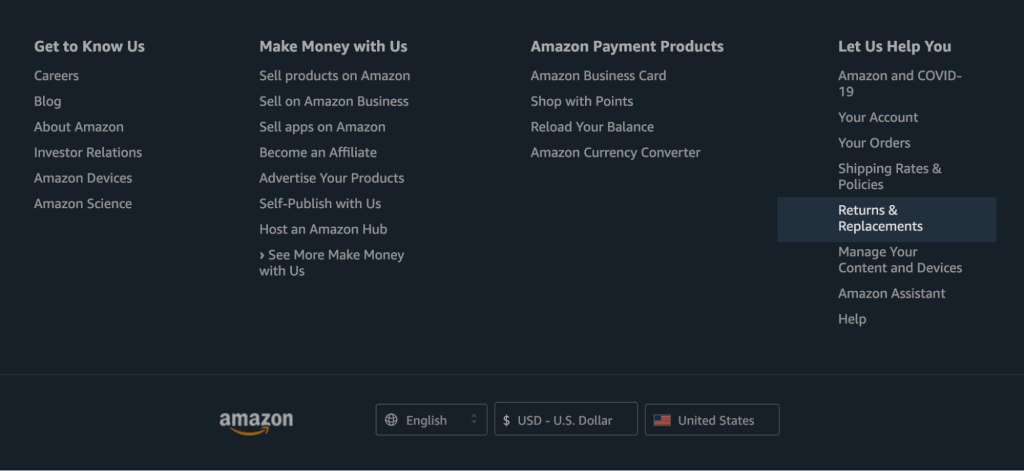
A

Don’t forget to put a link to your ecommerce return policy in order confirmation emails. This makes your customers feel
You can even provide examples with images for your customers in case they ever need to return the product.
If your customers are able to return a product in different ways, state the
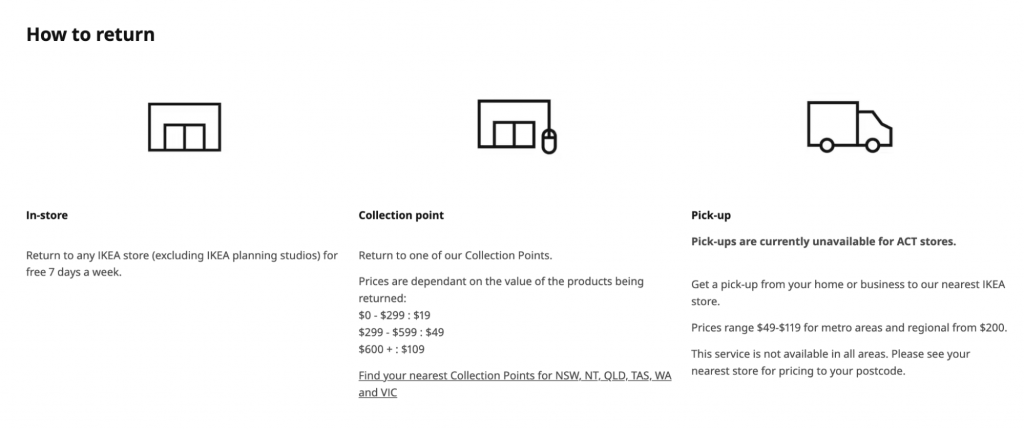
Don’t Blindly Copy Your Return Policy from Another Business
You should not copy some other business’s return policy. Not only does that look bad, but your return policy should be dependent on factors specific to your business. This includes industry type, business margins, and even business philosophy.
For example, if you’re selling clothes online, you will need to personalize your return policy to your specific business and target audience. You might want to accept returns on some product categories while excluding others, such as underwear.
It’s a good idea to have detailed instructions on your return policies for different product categories as well.
For example, the Target return policy includes a list of return exceptions:

There are various return policy templates you can use for your store instead of copying other brands’ policies. However, make sure to adjust the template to your business.
Apart from providing your address and return procedures, you need to specify the product conditions you will accept. For example, you may have a very detailed procedure for returning a damaged product, a unique list of
To make writing a return policy easier for you, we’ve prepared a template you can use. Download it and be sure to edit it to your business needs.
Make a Return Period Longer
Most online stores accept returns 30 or 60 days after the purchase. While this is good for improving trustworthiness, if your return period lasts for 90 days, 120 days, 365 days, or even for a lifetime, you will likely see a jump in your sales.
There are different reasons for extending return periods. For example, during the coronavirus pandemic, many retailers extended their return and exchange periods to give consumers more flexibility to get refunds and let their customer service reps process returns safely.
However, there are many reasons for extending your return period. One of them is that people are still skeptical of buying products online, especially
Extend your policy as long as you can because the majority of the customers will keep the product. They just want that extra security in knowing you have a reasonable return policy.
Keep the Language Simple
Write your return policy as if you’re having a conversation with your target audience. Keep the sentences short and to the point.
It shouldn’t take your customer more than a couple of minutes to figure out how your return policy works. Don’t make things overly complicated with legal jargon. It might confuse shoppers and increase the chances of them abandoning your website altogether.
When you use terms that are easy to understand, it becomes easier for your customers to follow your policy.
For example, the Walmart return policy states from the very beginning that they “make returns easy.” All customers have to do is click a button and enter the transaction number on the receipt to find their items and start a return process.
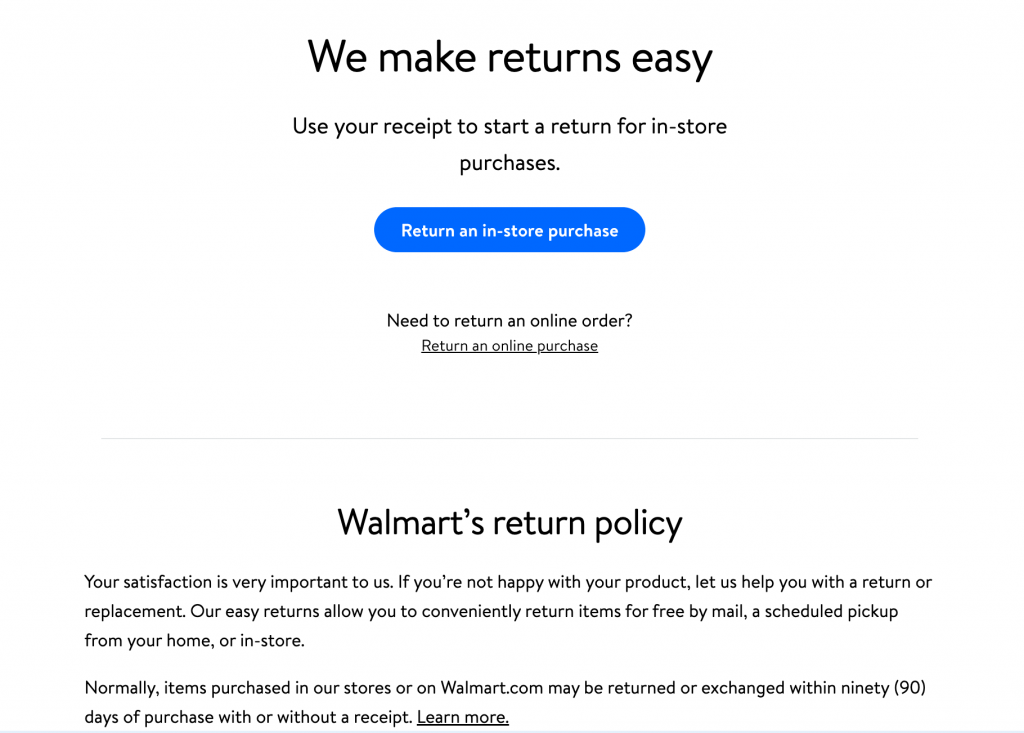
Another example is the Home Depot return policy: before diving into the details of the return process, they sum it up to show that it’s as

The policy is written in simple language without any legal jargon. They simply state that “returns are free and easy.”
Define the Expected Condition of the Returned Item
When writing your company’s return policy, explicitly say what condition you expect the product to be in when returned. Also, include instructions for how you expect the product to be packaged if you do.
You want to have a friendly return policy. But at the same time, it has to be fair. You don’t want customers returning you a broken phone or torn clothes. Failing to include this information will likely lead to customers misusing your return policy.
For example, the Best Buy return policy clearly states that items need to be returned in a
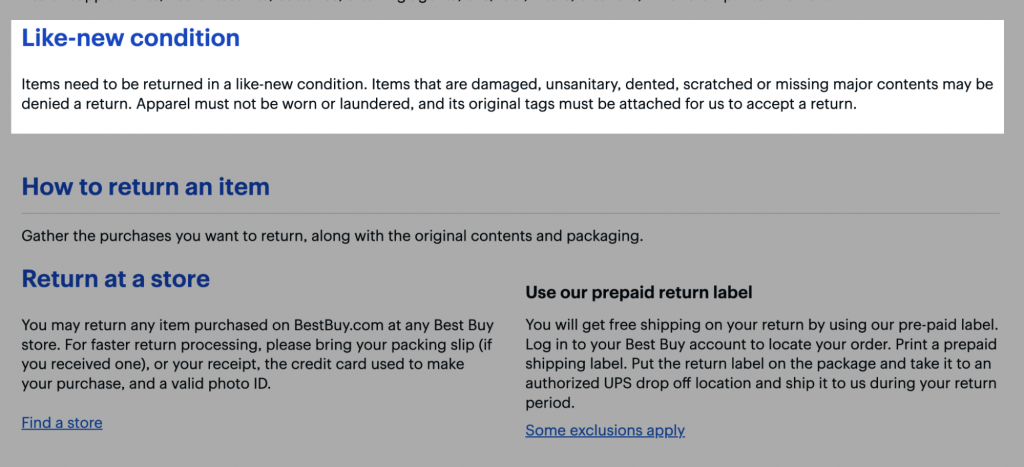
Decide Whether to Give a Full Refund or Store Credit
Sometimes customers want to return a product because they got the wrong size or color. You can offer them the option of
Many customers demand a full refund of their money, and stores often refund purchases in full. However, it’s worth offering
Do not push the
Another alternative to a refund is offering your customers a gift card equal to or more than the cost of the returned product.
Disclose Any Fees Associated With Returns
Are you charging your customers for the return shipping? Or are you taking care of returns and restocking? You need to clearly state that in your policy.
Failing to state any and all return fees beforehand will upset your customers. From their perspective, not only did you send them the wrong product, but you also want them to send it back to you at their expense.
Frustrated customers might go on social media and complain about your business. You definitely want to avoid that. Explain in your return policy when you expect your customers to pay and when you don’t.
For example, the Sephora return policy states that there are no return shipping or handling fees:

Plus, providing free shipping only helps to keep customers. If you can afford it, paying for return shipping gives a customer more than enough reason to come back and shop again.
Create a FAQ Page
Having a FAQ page goes a long way. It allows customers to quickly find answers to their questions.
FAQs particularly work well with
- “How long does the return and exchange policy last?”
- “How do I place a return request?”
- “Do I need to ship the product back myself?”
- “How do I check the status of my return?”
- And so on.
For inspiration, take a look at the FAQ for the SHEIN return policy:

Actively Promote Your Return Policy
Don’t just write a good return policy, but promote it everywhere you can: on your homepage, shopping cart, checkout pages, newsletters, and even in your offline promotions.
Make sure you mention your return policy everywhere it makes sense. You’ll be surprised how many new customers you can get by promoting your return policies.
According to Statista, 86% of global consumers surveyed responded that they looked for retailers with easy product return policies when deciding where to shop. 81% said they would switch to a different retailer if they had a bad experience with returning items.

Consumer attitudes towards return policy of retailers and its influence on their purchasing decision worldwide
By actively promoting your return policy, you can reel more customers in.
You could even go further by including a printed copy of your return policy inside every package you ship.
How to Use Your Return Policy to Increase Sales
Some companies have successfully built an entire business around their return policies. Zappos is one of them. Their
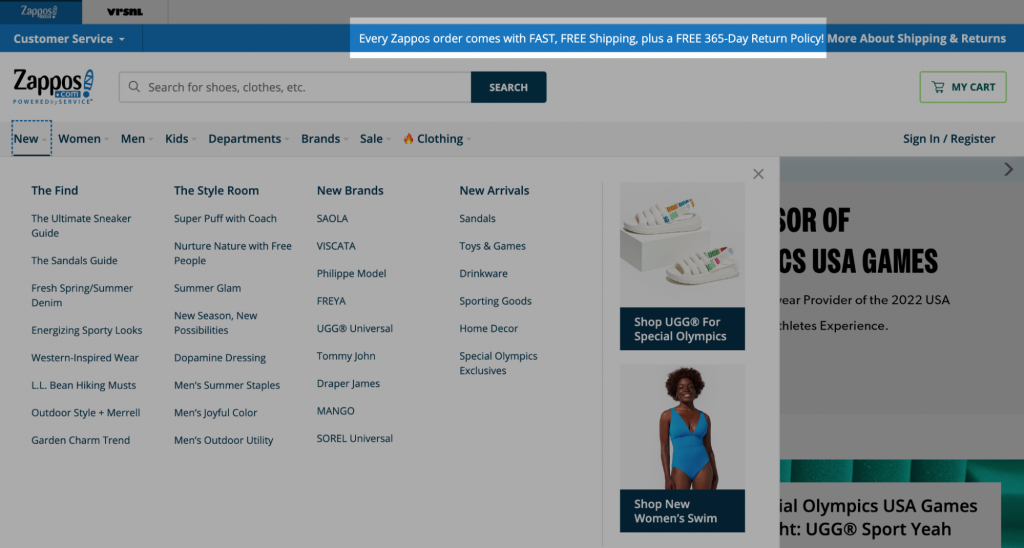
This extremely liberal return policy was used to make customers buy their products. Over time, as Tony Hsieh (Zappos’ founder) documents in “Delivering Happiness,” it became the differentiating factor and the foundation of their business ethos.
As a small business, you could also take advantage of highlighting your return policies. That will improve your conversion rate and positively affect how people perceive your brand.
Here are some tips for how to go about it:
Share Testimonials of Customers Who’ve Successfully Returned Products
When a customer returns an item, use their experience to your advantage.
Once you process the return, don’t be afraid to ask for a testimonial. Ask for their testimonial, name, and photo. You can add it to your “Return Policy” page.
When shoppers see testimonials, they’re more likely to buy from you. Always showcase the positive experiences of your customers on your business profiles on social media.
Be Liberal with Your Policies
Offering a generous return policy can act as a way to attract more customers. However, be sure to calculate the cost of returns before committing to an overly generous one.
For shoppers, “Free Shipping and Returns” is a dream come true. It means that they pay for what they see. If they don’t like it, they can send it back.
It’s also fairer to the customer. Surveys show that the main reason for online purchase returns worldwide is faulty, damaged,
But for a seller, free shipping and returns could quickly become a logistical nightmare. Figuring out how much money you will lose on returned sales could be a bigger problem than it looks. Your profit margins will undoubtedly go down in the short term.
That said, according to a survey by Power Reviews, 76% of respondents believe that free returns are important factors when shopping online.
Having a
The returns process isn’t just about bringing the item back to the warehouse. Sometimes you have to get the returned item back in stock, return it to the manufacturer, or sell it on the secondary market (the channels that provide a means to sell and buy returned or excess goods).
Keep this in mind when you create a liberal policy. Calculate how much money you are losing on each return, your average return rate, and the impact on your margin each return has.
Make Returns Quickly
Customers love when things happen quickly, whether it’s shipping or returns.
If you have the resources to accept returns within a couple of days, you should definitely do it. Efficiency leaves a good impression on your customers.
A great example is Warby Parker. With their “Home

Write Your Stellar Return Policy
You can’t run a successful ecommerce store without a return policy. Instead of treating returns as a hassle, see it as an opportunity to build your brand and flex your logistical muscles.
Use the above tips to craft a return policy that’s
- Identify your return rate. This is the percentage of total orders returned by customers. Here’s the formula: (Cost of Orders Returned / Total Sales) x 100.
- Keep your return rate in mind to calculate whether you can offer a more lenient return policy (say,
90-180 days). - Choose a couple of stores whose return policy and policy page you admire. Pick actionable insight from each policy.
- Consult a lawyer and craft a policy that encapsulates your brand philosophy and assists customers. This will depend on the country you live in, so it’s important to find a lawyer who understands your industry and works well with you.
And remember: a return policy is a legal document. Use the advice in this article to guide you in the right direction. However, you should definitely consult your lawyer before you commit to a return policy.
Now you know how to write an effective return policy. Once you get it up on your website, make sure it works for you and your customers. Not only can it strengthen your relationship with your customers, but it can also attract more buyers. Start working on setting up a fair and effective return policy today!
- Legal Docs for Online Stores: Protection and Trust
- How to Write a Privacy Policy for Your Ecommerce Store
- How to Write an Effective Return Policy
- 25 Places to Find
Low-Cost Legal Advice - Understanding the Terms and Conditions Page
- Registering Your Ecommerce Business
- Protecting the Brand: How To Register a Trademark








